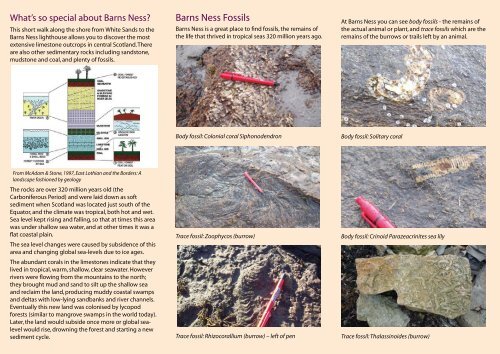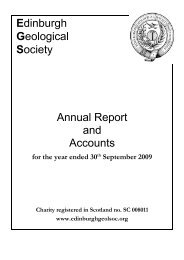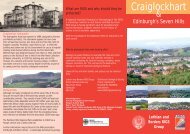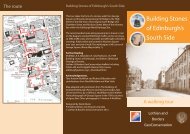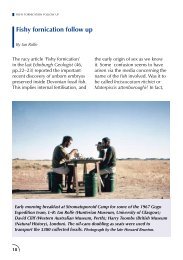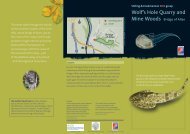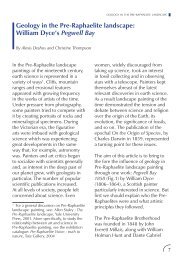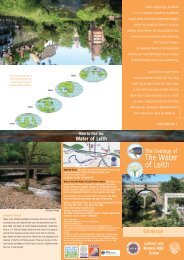A4 pdf version - Edinburgh Geological Society
A4 pdf version - Edinburgh Geological Society
A4 pdf version - Edinburgh Geological Society
You also want an ePaper? Increase the reach of your titles
YUMPU automatically turns print PDFs into web optimized ePapers that Google loves.
What’s so special about Barns Ness<br />
This short walk along the shore from White Sands to the<br />
Barns Ness lighthouse allows you to discover the most<br />
extensive limestone outcrops in central Scotland. There<br />
are also other sedimentary rocks including sandstone,<br />
mudstone and coal, and plenty of fossils.<br />
Barns Ness Fossils<br />
Barns Ness is a great place to find fossils, the remains of<br />
the life that thrived in tropical seas 320 million years ago.<br />
At Barns Ness you can see body fossils - the remains of<br />
the actual animal or plant, and trace fossils which are the<br />
remains of the burrows or trails left by an animal.<br />
Body fossil: Colonial coral Siphonodendron<br />
Body fossil: Solitary coral<br />
From McAdam & Stone, 1997, East Lothian and the Borders: A<br />
landscape fashioned by geology<br />
The rocks are over 320 million years old (the<br />
Carboniferous Period) and were laid down as soft<br />
sediment when Scotland was located just south of the<br />
Equator, and the climate was tropical, both hot and wet.<br />
Sea level kept rising and falling, so that at times this area<br />
was under shallow sea water, and at other times it was a<br />
flat coastal plain.<br />
The sea level changes were caused by subsidence of this<br />
area and changing global sea-levels due to ice ages.<br />
The abundant corals in the limestones indicate that they<br />
lived in tropical, warm, shallow, clear seawater. However<br />
rivers were flowing from the mountains to the north;<br />
they brought mud and sand to silt up the shallow sea<br />
and reclaim the land, producing muddy coastal swamps<br />
and deltas with low-lying sandbanks and river channels.<br />
Eventually this new land was colonised by lycopod<br />
forests (similar to mangrove swamps in the world today).<br />
Later, the land would subside once more or global sealevel<br />
would rise, drowning the forest and starting a new<br />
sediment cycle.<br />
Trace fossil: Zoophycos (burrow)<br />
Trace fossil: Rhizocorallium (burrow) – left of pen<br />
Body fossil: Crinoid Parazeacrinites sea lily<br />
Trace fossil: Thalassinoides (burrow)


